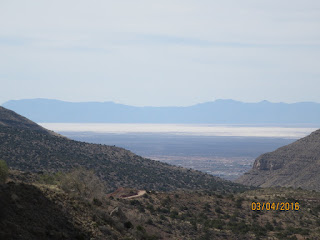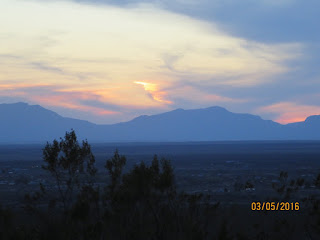The sand is actually gypsum. Crystals form, called selenite, on the bottom of the Lake Lucerne. This lake only fills part of the year during the wet season and the rest of the year is dry. The crystals emerge from the mud. The sun and beating of the wind cause the selenite to flake and be blown around and erode into smaller and smaller pieces. These pieces reflect light rather than letting it pass through and give the gypsum sand its snowy look. It is so white it almost hurts your eyes.
 |
| Our first glimpse of the sands heading through a mountain pass |
 |
| Sunset from our campsite in Oliver Lee State Park in Alamogordo New Mexico |
 |
| Not really a selfie |
 |
| As far as you can see |
 |
| These little tufts could be the top of a very large cactus buried in the dune but help told them in place |
 |
| This family was enjoying sledding at the dunes without all the winter clothing we need to make sledding in snow pleasant, in Michigan, in January. |
 |
| Larry of Arabia? |
 |
| Nighttime Trespassers? |
 |
| This is a plant that has gypsum crusted around its bottom to keep it protected from the moving sand and wind. It has trapped in whatever moisture it can to help it survive. |
 |
| These reminded me of covered wagons but are actually covered areas to picnic out of the sun at White Sands |

No comments:
Post a Comment